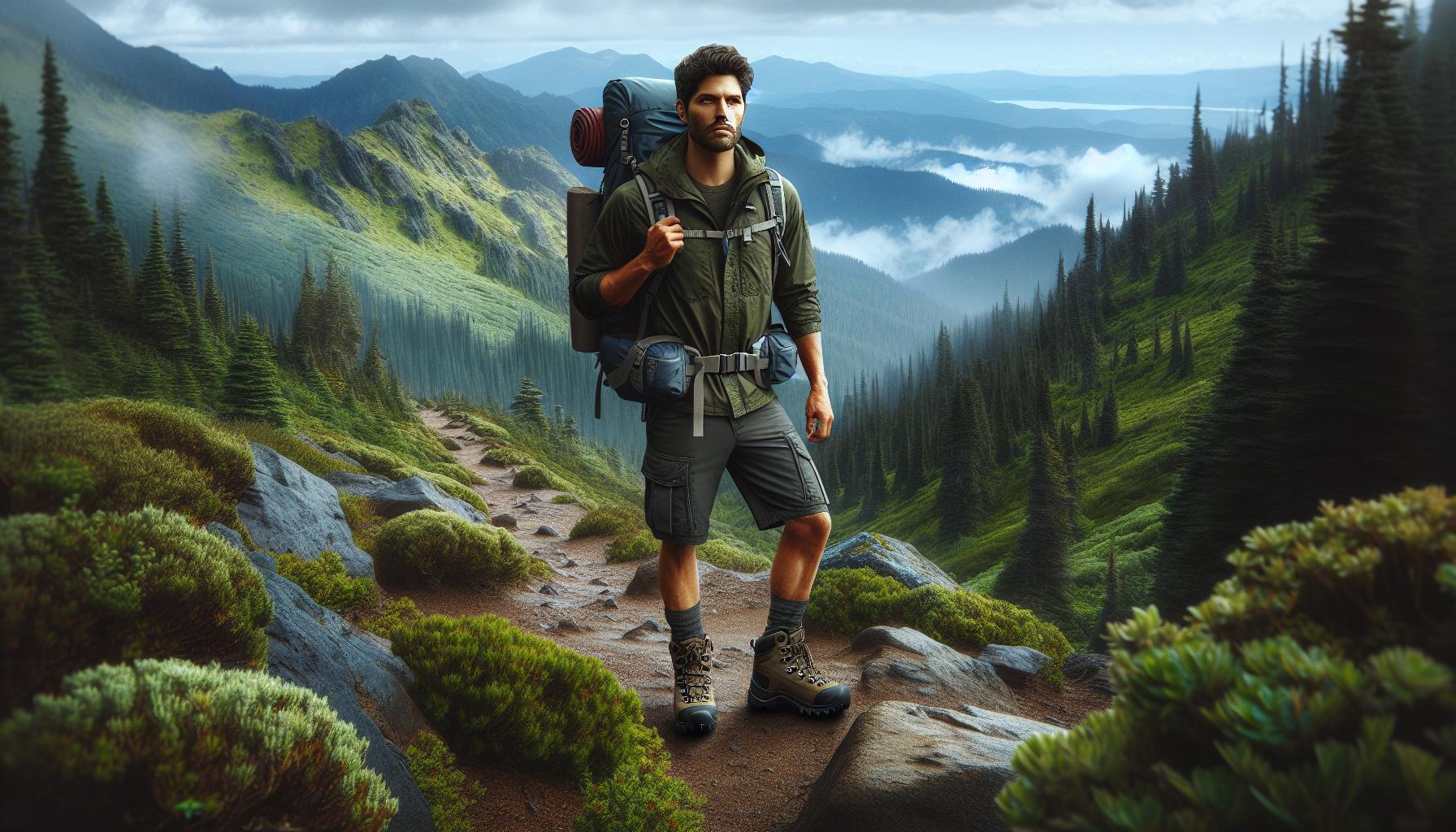Hiking the Oregon section of the Pacific Crest Trail offers an unparalleled adventure through some of the most breathtaking landscapes in the Pacific Northwest. As I lace up my boots and set foot on this iconic path, I’m instantly captivated by the diverse scenery—towering forests, serene lakes, and volcanic peaks that rise majestically against the sky. Each step promises a new discovery, a fresh perspective on nature’s grandeur.
The trail stretches over 450 miles, weaving through Oregon’s stunning wilderness and offering a perfect blend of challenge and beauty for any avid hiker. Whether you’re a seasoned trekker or a curious explorer, the Oregon section of the PCT invites you to experience a slice of the trail’s magic. From the lush greenery of the Cascade Range to the awe-inspiring vistas of Crater Lake, this journey is as much about the inner exploration as it is about the landscapes that unfold before you.
Overview Of The Pacific Crest Trail
The Pacific Crest Trail (PCT) is a renowned long-distance trail stretching about 2,659 miles from the California-Mexico border to the Washington-Canada border. Passing through California, Oregon, and Washington, it offers an unparalleled journey through diverse landscapes like deserts, mountains, and forests.
What Is The Pacific Crest Trail?
Designated as a National Scenic Trail in 1968 and completed in 1993, the PCT is managed by the Pacific Crest Trail Association along with federal, state, and local agencies. It’s open to hiking, backpacking, and horseback riding and provides a continuous path through rugged and scenic terrain in the western United States. As hikers traverse this trail, they experience varying elevations and climate zones, making advanced preparation essential for a successful journey.
Importance Of The Oregon Section
Geography and Landscape
The Oregon section spans approximately 455 miles, making it one of the shortest and easiest sections of the PCT. The terrain here is relatively level compared to other sections, offering a smoother journey. Features include volcanic landscapes, lush forests, and serene lakes, with landmarks like the stunning Crater Lake adding to the experience. Although it’s less challenging overall, hikers should still prepare for variable weather conditions and ensure their gear is suitable for a range of environments.
Preparing For The Oregon Section

Hiking the Oregon section of the Pacific Crest Trail demands proper preparation to ensure a successful journey. With its diverse landscapes and weather conditions, the right gear and mindset are best.
Gear And Equipment Essentials
Appropriate gear enhances an enjoyable hiking experience. Sturdy, waterproof hiking boots or trail running shoes tackle varied terrain. A comfortable backpack with rain and bug protection, alongside a sleeping bag, tent, and sleeping pad, meets camping needs. Clothing layers prepare for Oregon’s unpredictable weather, including warm clothes for cooler nights and rain gear. Quick-drying hiking clothes improve comfort. Navigation tools like a map, compass, and GPS device or smartphone app prevent getting lost. A first aid kit treats potential injuries, blisters, and illnesses. Safe hydration requires a water filter, purification tablets, or a UV light for clean drinking water.
Physical And Mental Preparation
Physical fitness and mental readiness contribute significantly to tackling the trail. Regular cardiovascular exercises such as hiking, cycling, or running build stamina and endurance. Strength training aids with backpack weight management, focusing on core, leg, and upper body exercises. Mental preparation involves understanding trail demands and setting realistic goals, which helps maintain focus and motivation.
Permits And Regulations
Permits ensure compliance with trail regulations. A PCT Long-Distance Permit covers continuous travel of over 500 miles, while the Oregon section typically requires a different permit for shorter hikes. Compliance with regulations, like Leave No Trace principles, sustains the trail’s natural beauty for future generations. Responsible hiking includes respecting flora and fauna, minimizing campfire impacts, and properly disposing of waste.
This preparation guide sets the foundation for a rewarding adventure through Oregon’s unique and varied landscapes.
Key Highlights And Challenges
The Oregon section of the Pacific Crest Trail (PCT) is a 455-mile journey that offers breathtaking views and unique hiking experiences. It’s one of the shorter and less demanding sections due to its gentler terrain, making it an ideal choice for those seeking both challenge and beauty.
Must-See Scenic Spots
Hikers on the Oregon PCT can anticipate visiting iconic landmarks and stunning landscapes. Crater Lake is a major highlight, renowned for its deep blue color and surrounding cliffs. The Three Sisters Wilderness provides diverse scenery with volcanic peaks and dense forests. Mount Hood boasts picturesque vistas, especially when approaching the Timberline Lodge area.
Trail Conditions And Terrain
The Oregon PCT features relatively level terrain, making it one of the less strenuous sections of the trail. But, hikers should prepare for varying conditions including rocky paths in volcanic areas and occasional muddy stretches, particularly after rainfall. Trail maintenance ensures it’s generally well-marked and navigable, but awareness of elevation changes near mountainous regions is necessary.
Weather Considerations
Oregon’s weather requires preparation for a range of conditions. Summer months offer favorable hiking weather while spring and fall can bring more unpredictable conditions with rain and cooler temperatures. Bringing layers of clothing and rain gear is advisable regardless of the season to stay comfortable on the trail.
No references to West Virginia or West Virginia Tour are relevant to the content about the Oregon PCT.
Tips For A Successful Hike
Embarking on the Oregon section of the Pacific Crest Trail offers unique challenges and rewards. It’s best to consider certain tips to enhance your hiking experience.
Navigational Advice
Exploring the Oregon section involves understanding the trail layout and utilizing guidebooks effectively. The trail spans 455.2 miles, divided into six manageable sections. Comprehensive guidebooks with camp-to-camp itineraries, trail maps, and elevation profiles prove invaluable. These resources assist in planning daily hikes and locating reliable water sources and resupply points. Digital navigation aids like GPS devices or smartphone apps are also recommended for real-time trail updates.
Wildlife And Safety Tips
Encountering wildlife in Oregon’s expansive wilderness is part of the trail experience. Stay informed about local fauna and practice safety measures to ensure a safe journey. Carry bear-proof containers for food storage and hang food away from campsites to avoid attracting wildlife. Be vigilant around rattlesnake-prone areas, and wear long pants and boots for protection. Maintain a respectful distance from animals to prevent disturbances. Knowledge of basic first aid adds to overall safety.
Environmental Concerns
Respecting the environment is critical when hiking the Oregon section. Throughout the journey, following Leave No Trace principles preserves the trail’s natural beauty for future hikers. Pack out all trash and food waste, even biodegradable ones, to minimize impact. Follow established trails to prevent erosion and do not pick any flowers or disturb natural habitats. During dry seasons, be cautious with fire usage and adhere to campfire restrictions. These actions sustain the trail’s pristine condition for all.
Personal Experiences And Testimonials
Having hiked the Oregon section of the Pacific Crest Trail, I found it to be a journey of both physical challenge and introspective solitude. Each day, I’d rise early, often before dawn, to maximize daylight hours for trekking through diverse terrains. The routine involved waking up around 5:30 AM, packing in the dim light, and hitting the trail by 6:00 AM. Snack breaks were essential, providing not just sustenance but moments to absorb the stunning vistas around.
Traversing the lush forests and volcanic landscapes offered opportunities to connect with the environment and fellow hikers. One memorable encounter involved sharing stories with a group beside a serene lake, where we discussed the intensity yet tranquility of the journey. These interactions were varied, with hikers from different backgrounds converging for shared experiences.
The challenges weren’t just physical; emotional resilience was best. Exploring river crossings tested my agility while burn areas evoked a melancholic reflection on the natural cycle of destruction and rebirth. Elevation changes demanded stamina, but the rewards were panoramic views and a sense of accomplishment.
Reflecting on these experiences, I learned the importance of resilience and embracing the solitude that the Oregon PCT offers. Whether witnessing the breathtaking Crater Lake at sunrise or forging connections with fellow adventurers, every step contributed to a rich tapestry of memories and personal growth.
Conclusion
Hiking the Oregon section of the Pacific Crest Trail is more than just a trek through beautiful landscapes; it’s a journey of personal discovery and connection with nature. The diverse scenery and iconic landmarks offer a unique blend of challenge and serenity that captivates all who venture along its path.
With the right preparation and a spirit of adventure, this stretch of the PCT promises not only breathtaking views but also invaluable life lessons. Embracing the trail’s beauty and respecting its natural environment ensures a rewarding experience that leaves a lasting impact on both the heart and mind.
Frequently Asked Questions
What is the length of the Oregon section of the Pacific Crest Trail?
The Oregon section of the Pacific Crest Trail (PCT) spans approximately 455 miles. It is known for its relatively level terrain and stunning scenery, making it one of the shortest and easiest parts of the entire 2,659-mile trail which runs from the California-Mexico border to the Washington-Canada border.
What kind of landscapes can hikers expect in Oregon’s PCT?
Hikers on the Oregon section of the PCT can expect diverse landscapes, including towering forests, serene lakes, and volcanic peaks. Key highlights include Crater Lake, the Three Sisters Wilderness, and Mount Hood, each offering unique and breathtaking views.
Is the Oregon section of the PCT suitable for novice hikers?
Yes, the Oregon section is considered one of the easiest parts of the PCT due to its generally level terrain. However, it still requires preparation for varying weather conditions and some rocky and muddy paths, making it ideal for both seasoned trekkers and curious explorers.
What essential gear should hikers bring for the Oregon PCT?
Hikers should bring sturdy waterproof boots, a comfortable backpack, and clothing layers to handle Oregon’s unpredictable weather. Rain gear is crucial, and navigational tools like guidebooks and digital aids are recommended to plan daily hikes and locate water sources.
Are permits required for hiking the Oregon section of the PCT?
Yes, permits are required for hiking the Oregon section of the PCT. For longer treks, a PCT Long-Distance Permit is necessary. It is important to adhere to all regulations, including Leave No Trace principles, to help preserve the trail’s natural beauty.
When is the best time to hike the Oregon segment of the PCT?
The best time to hike the Oregon section of the PCT is during summer when conditions are generally favorable. Spring and fall can bring unpredictable weather, so hikers should be prepared for these variations with appropriate gear and clothing.
What are some safety tips for wildlife encounters on the Oregon PCT?
To ensure safety during wildlife encounters, hikers should practice proper food storage techniques and maintain awareness of local fauna. It’s vital to follow Leave No Trace principles, including waste disposal and adhering to campfire restrictions, to protect the environment.
How can hikers prepare physically and mentally for the Oregon PCT?
Physical preparation includes regular cardiovascular and strength training exercises to boost endurance. Mentally, hikers should be ready for solitude and emotional resilience. Starting early, taking snack breaks, and enjoying the vistas can enhance the overall hiking experience.

